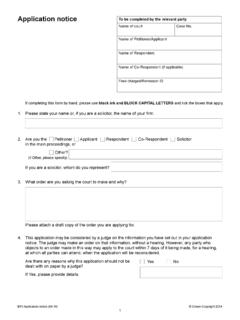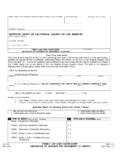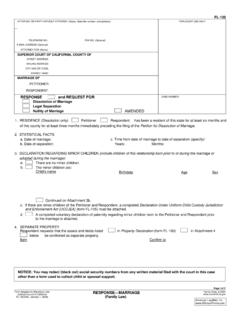Transcription of California Courts: Self-Help Center - gourdbanjo.com
1 California Courts Self-Help Center Instructions for petition (Family Law), Form FL-100. Top Part of Form Put your name, current address, and daytime phone number at the top of the form. If you don't have a lawyer, write "in pro per" after "Attorney for.". Fill in the court name and address. You may also need to fill in the court branch where you will file your petition . If you are the person starting the court case, you are the Petitioner. Your spouse is the Respondent.. The court clerk will give you a case number when you file the first set of forms.
2 Use this case number on all your forms. Date of Separation (number 2b). This is the date when you and your spouse knew your marriage was over, even if you were still living together. You may need to talk to a family law lawyer to decide what the date of separation was, especially if you and your spouse lived apart or had trial separations in the past. ALERT! The date between the date of your marriage and date of separation will define the length of your marriage. The Length of Marriage can seriously affect the division of property and debts and payment of spousal support!
3 Minor Children (number 3). List the children you and your spouse had or adopted who are now under 18. Fill out and file a Declaration Under Uniform Child Custody Jurisdiction and Enforcement Act (form FL-105). This form tells the judge: Where your child has been living, Who your child has been living with, and If there have been any other court cases about custody of your child (including juvenile, guardianship, or domestic violence cases). List Property and Debts (numbers 4 and 5). List what you own (money or property) and what you owe (loans or debts).
4 Say whether these things are owned by both of you (community property) or only one of you (separate property). Instructions for Form FL-100. Page 1 of 5. ALERT! The property and debts part of the divorce is often so complicated and the cost of making a mistake is so high that it is a good idea to talk to a lawyer before you file your papers. If you leave this section blank, you are saying there is no property or debt to consider. Check the box that is appropriate for your case. If you need more room to list assets or debts, attach another page and label it "Attachment 5 to petition .
5 " Give as much information as possible. Don't forget to list pension and retirement benefits, IRA accounts, 401(k) plans, life insurance policies, security deposits, and promissory notes. When you list debts, include unpaid taxes, medical bills, credit card accounts, and other loans or mortgages. You do not have to list things like clothing, pots and pans, books, and other smaller items. Community property Generally, everything you bought while you were married is community property, even if only one of you earned or spent the money. You may have more community property than you realize.
6 (See below.) Examples of community property might be an interest in your spouse's pension or profit-sharing plan. You may also have more community debts than you realize. Most debts incurred by either party during the marriage are community debts, even if a credit card was in the name of one spouse only. Community property and community debts are usually divided equally. ALERT! Community property does not become separate property (even if you and your spouse have agreed on how to divide it) until the judge signs the final court order. Separate property As a married person, your separate property includes: All property you owned before the marriage.
7 All property given to you as a gift or inheritance -- even if the gift or inheritance occurred during the marriage;. The rents, profits, or other money earned from your separate property;. and Property you got after the date of separation. Also, if you or your spouse has spent any of your separate property on assets that are community property, you may be entitled to a reimbursement of your separate property. The division of property can be very complicated and you should see a lawyer! Instructions for Form FL-100. Page 2 of 5. When you list separate property and debts, say if each listed item belongs to the petitioner or the respondent.
8 Mixed community and separate property Sometimes things are part separate property and part community property. For example, you or your spouse might have a pension or retirement benefit from a job held before and during the marriage. So, it would be separate property (earned before the date of marriage) and then community property (earned between the date of marriage and the date of separation) and back to separate property again (earned after the date of separation). Exactly how the pension would be divided is complicated. Another example might be where your spouse owned a house before the date of your marriage (their separate property), but after the marriage payments on the house were made from community property.
9 The community property interest in the house would have to be determined -- and it is quite complicated to do. If you believe you have issues of mixed property, you should see a lawyer. ALERT! If you signed a property agreement before or during the marriage, talk to a lawyer to see how this affects your case before you file your papers with the court . Grounds for Divorce or Separation (boxes 6a and 6b). If you want a dissolution (divorce) or a legal separation, check box 6a or 6b. Then, check the box that best explains why you want the divorce (box 6a(1) or 6a(2)) or legal separation (box 6b(1) or 6b(2)).
10 Most people check irreconcilable differences (box 6a(1) or 6b(1)). This means you and your spouse just could not make your marriage work. You do not need to say whose fault it is. In fact, the court will not consider who is at fault in deciding the issues of your case. Grounds for Annulment (Nullity of Marriage) (boxes 6c(1) (2) and 6d(1) (6)). If you ask the judge to annul your marriage, you will have to go to court and prove that at the time of the marriage: You were closely related to your spouse (incest);. One of you was under 18, still married to someone else, or mentally ill.






